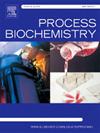基于活性导向方法的层状多糖功能化硒纳米粒子的构建与表征
IF 3.7
3区 生物学
Q2 BIOCHEMISTRY & MOLECULAR BIOLOGY
引用次数: 0
摘要
研究表明,层藻多糖(LP)可有效稳定硒纳米粒子(SeNPs),形成具有更强生物活性的 LP-SeNP 复合物。然而,其生物活性与理化性质之间的相关性仍未得到充分探讨。本研究采用化学还原法,以 LP 为稳定剂,研究 LP 与硒的质量比(LPSMR)、反应时间和温度如何影响 LP-SeNPs 的粒径、硒含量和 2,2-二苯基-1-苦基肼(DPPH)自由基清除活性。结果表明,DPPH 自由基清除活性的增强与硒含量的提高和粒径的减小有关,主要受 LPSMR 和温度的调节。在最佳条件下(LPSMR 为 1;温度为 25°C),生成的 LP-SeNPs 形状均匀,粒径为 81.41 nm,硒含量为 653.91 mg/g。这种稳定性是通过 LP 与 SeNPs 之间的非共价相互作用实现的,与未改性 SeNPs 相比,具有更出色的耐光性和耐酸性。值得注意的是,LP-SeNPs 具有协同抗氧化作用,其清除 DPPH、羟基和超氧阴离子自由基的半最大抑制浓度 (IC50) 值低于单独使用 LP 或 SeNPs 时的数值,而且其降血糖活性也有所增强。细胞毒性试验证实,与 Na2SeO3 和硒肽相比,LP-SeNPs 的毒性更低。这些发现有助于深入了解 LP-SeNPs 的结构-活性关系,并支持其作为抗氧化剂和降血糖剂的潜在应用。本文章由计算机程序翻译,如有差异,请以英文原文为准。
Construction and characterization of Laminaria polysaccharide functionalized selenium nanoparticles based on an activity-oriented approach
Laminaria polysaccharides (LP) have been shown to effectively stabilize selenium nanoparticles (SeNPs), forming LP–SeNP complexes with enhanced bioactivity. However, the correlation between their bioactivity and physicochemical properties remains inadequately explored. This study used chemical reduction with LP as stabilizer to investigate how LP-to-selenium mass ratio (LPSMR), reaction time, and temperature influence particle size, selenium content, and 2,2-diphenyl-1-picrylhydrazyl (DPPH) radical scavenging activity of LP–SeNPs. The results showed that enhanced DPPH scavenging correlated with higher selenium content and smaller particle size, primarily modulated by LPSMR and temperature. Under optimal conditions (LPSMR of 1; temperature of 25°C), the resulting LP–SeNPs exhibited uniform morphology with a particle size of 81.41 nm and selenium content of 653.91 mg/g. This stability was achieved through non-covalent interactions between LP and SeNPs, providing superior light and acid resistance compared to unmodified SeNPs. Notably, LP–SeNPs showed synergistic antioxidant effects, with lower half-maximal inhibitory concentration (IC50) values for scavenging DPPH, hydroxyl, and superoxide anion radicals than LP or SeNPs alone, and enhanced hypoglycemic activity. Cytotoxicity assays confirmed LP–SeNPs had reduced toxicity compared to Na2SeO3 and selenopeptide. These findings provide insights into the structure-activity relationships of LP–SeNPs and support their potential application as antioxidant and hypoglycemic agents.
求助全文
通过发布文献求助,成功后即可免费获取论文全文。
去求助
来源期刊

Process Biochemistry
生物-工程:化工
CiteScore
8.30
自引率
4.50%
发文量
374
审稿时长
53 days
期刊介绍:
Process Biochemistry is an application-orientated research journal devoted to reporting advances with originality and novelty, in the science and technology of the processes involving bioactive molecules and living organisms. These processes concern the production of useful metabolites or materials, or the removal of toxic compounds using tools and methods of current biology and engineering. Its main areas of interest include novel bioprocesses and enabling technologies (such as nanobiotechnology, tissue engineering, directed evolution, metabolic engineering, systems biology, and synthetic biology) applicable in food (nutraceutical), healthcare (medical, pharmaceutical, cosmetic), energy (biofuels), environmental, and biorefinery industries and their underlying biological and engineering principles.
 求助内容:
求助内容: 应助结果提醒方式:
应助结果提醒方式:


